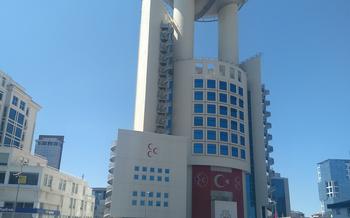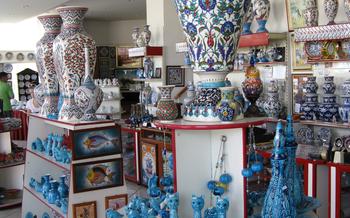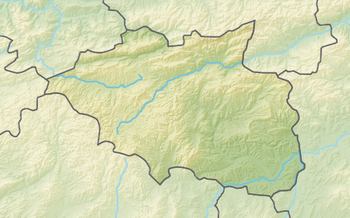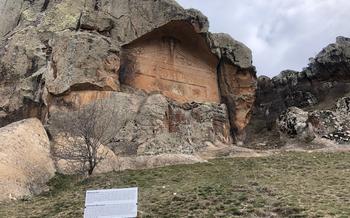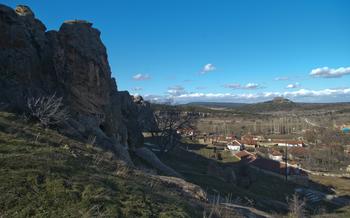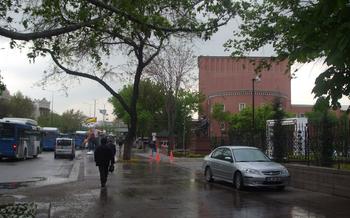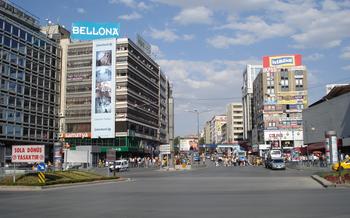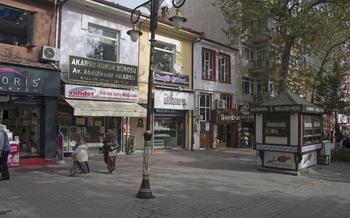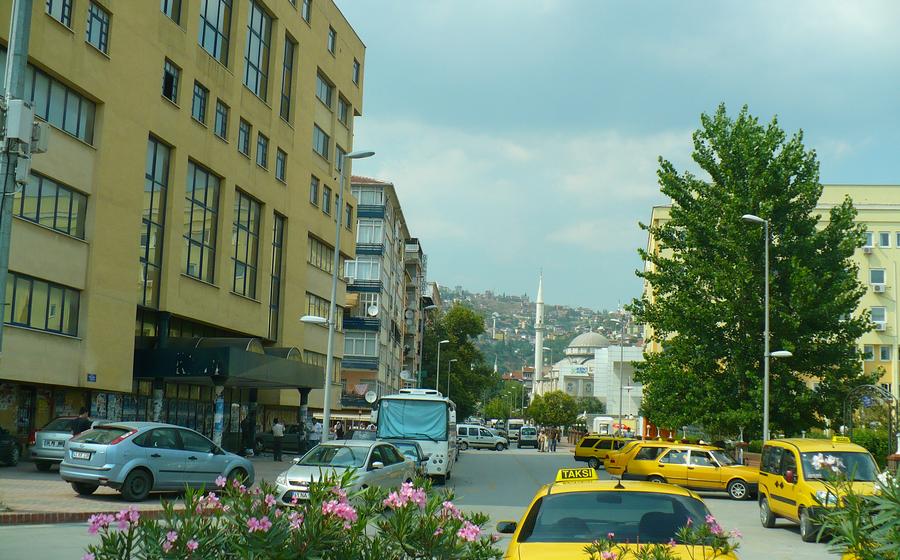
Tavşancıl Phrygian Rock Monuments
- Tavşancıl Phrygian Rock Monuments: A Journey into Ancient History
- Exploring the Rock-Cut Reliefs
- Immerse Yourself in the Phrygian Culture
- A Walk Through Ancient History: The Surrounding Area
- Unveiling the Secrets of the Rock Monuments
- A Photographer's Paradise: Capturing the Beauty
- Getting There: Transportation Options
- Planning Your Visit: Accommodations and Amenities
- A Step Back in Time: The Village of Tavşancıl
- Local Cuisine: A Culinary Adventure
- Safety and Precautions: Ensuring a Smooth Visit
- Respecting the Monuments: A Cultural Heritage
- Engaging with the Locals: Cultural Exchange
- Insider Tip: Unveiling Hidden Secrets
Tavşancıl Phrygian Rock Monuments: A Journey into Ancient History
Embark on a captivating journey through time as you explore the Tavşancıl Phrygian Rock Monuments, a testament to the rich cultural heritage of ancient Anatolia. These awe-inspiring rock-cut reliefs, dating back to the 8th century BC, offer a glimpse into the fascinating world of the Phrygians, an enigmatic civilization that once flourished in this region. Located in the picturesque town of Tavşancıl, in the Kocaeli province of Turkey, these monuments stand as silent witnesses to a bygone era, inviting you to unravel their secrets.
With an entrance fee of 10 Turkish Lira (approximately $50) and operating hours from 8 am to 5 pm daily, the Tavşancıl Phrygian Rock Monuments welcome visitors to immerse themselves in the wonders of ancient history. The best time to visit is during the spring or fall, when the weather is pleasant and the surrounding landscapes are at their most vibrant. As you approach the site, a sense of awe washes over you, as if you are stepping back in time to witness the grandeur of a civilization that left an indelible mark on the region.
Exploring the Rock-Cut Reliefs
The Tavşancıl Phrygian Rock Monuments are renowned for their intricate rock-cut reliefs, which offer a captivating glimpse into the beliefs and practices of the ancient Phrygian civilization. These reliefs, carved directly into the rock face, depict a variety of symbols, figures, and scenes, each holding profound significance.
One of the most striking features of the rock carvings is their symbolic representation. Animals, such as lions, bulls, and stags, are prevalent throughout the reliefs, symbolizing strength, power, and fertility. The human figures depicted often display gestures of prayer or offering, suggesting their role in religious rituals.
Identifying the various figures and scenes portrayed in the rock carvings is a captivating endeavor. Among the most prominent figures are Phrygian deities, recognizable by their distinctive headdresses and attributes. Scenes of daily life, such as hunting, feasting, and dancing, provide insights into the social and cultural aspects of Phrygian society.
Of particular interest is the presence of Phrygian inscriptions alongside the rock carvings. These inscriptions, written in the Phrygian language, offer valuable clues to the history and culture of this ancient civilization. While the Phrygian language is not yet fully deciphered, ongoing research efforts are shedding light on its mysteries, revealing insights into the beliefs and practices of the Phrygian people.
The Tavşancıl Phrygian Rock Monuments served as significant religious sites for the Phrygians, where they performed rituals, offered prayers, and sought divine favor. The carvings depict scenes of religious ceremonies, including processions, sacrifices, and offerings. These reliefs offer a glimpse into the spiritual beliefs and practices of the Phrygian civilization, providing a deeper understanding of their connection to the divine.
Immerse Yourself in the Phrygian Culture
The Phrygians, an ancient civilization that flourished in central Anatolia from the 12th to 7th centuries BC, left an indelible mark on the region. Their rich culture, influenced by both Eastern and Western traditions, can be glimpsed through the rock-cut reliefs at Tavşancıl. The Phrygians were skilled metalworkers, and their art often depicted scenes of hunting, warfare, and religious rituals.
Historical Background of the Phrygian Civilization
The Phrygians originated from the Balkans and migrated to Anatolia around 1200 BC. They established a powerful kingdom with its capital at Gordion, near modern-day Ankara. The Phrygians were known for their military prowess and their skill in horsemanship. They also developed a sophisticated system of writing, the Phrygian script, which is still being deciphered today.
Influence of Phrygian Culture on the Region
The Phrygians played a significant role in the development of Anatolian culture. Their art and architecture influenced the later Hellenistic and Roman civilizations. The Phrygians were also known for their music and their religious practices, which included the worship of the Great Mother Goddess, Cybele.
Discovering the Unique Characteristics of Phrygian Art and Architecture
The rock-cut reliefs at Tavşancıl provide a glimpse into the unique artistic style of the Phrygians. Their art is characterized by its bold, geometric forms and its emphasis on narrative. The Phrygians were also skilled builders, and their cities were often adorned with impressive fortifications, temples, and palaces.
Visiting Other Phrygian Sites in the Vicinity
In addition to Tavşancıl, there are several other Phrygian sites in the vicinity that are worth exploring. These include the ancient city of Gordion, the site of the Phrygian royal tombs, and the Midas Mound, a large tumulus believed to be the burial place of King Midas.
A Walk Through Ancient History: The Surrounding Area
Beyond the captivating rock monuments themselves, the surrounding area of Tavşancıl is a treasure trove of ancient history and cultural heritage. Embark on a journey into the past as you explore the ruins of Germe, an ancient city that once thrived during the Roman era. Discover the remains of a magnificent theater, where actors once performed for captivated audiences, and marvel at the impressive aqueduct that brought water to the city.
As you venture further, visit the nearby villages and towns, each with its unique charm and stories to tell. Engage with the welcoming locals, learn about their traditions, and savor the delicious local cuisine. Indulge in traditional Turkish dishes, sample regional specialties, and visit local markets for fresh produce and ingredients. This immersive experience will not only transport you back in time but also provide a glimpse into the vibrant culture that continues to thrive in this region.
Unveiling the Secrets of the Rock Monuments
Archaeological research and excavations have been ongoing at the Tavşancıl Phrygian Rock Monuments for decades, shedding light on the history and significance of this ancient site. Archaeologists have uncovered a wealth of artifacts, including pottery, tools, and inscriptions, which have helped to piece together the story of the Phrygian civilization. Ongoing efforts are being made to decipher the Phrygian language, which remains a mystery to scholars. The unique symbols and inscriptions found on the rock carvings have sparked much debate and speculation about the purpose and meaning of these enigmatic monuments.
Theories abound regarding the significance of the Tavşancıl Phrygian Rock Monuments. Some scholars believe that the site was a religious sanctuary, while others suggest that it may have been a royal necropolis or a gathering place for political and social events. Excavations have revealed evidence of ritual activities, such as animal sacrifices and the burning of offerings, which support the theory that the site had a religious function. Future plans are in place to further explore and preserve this remarkable site, ensuring that its secrets continue to be revealed for generations to come.
A Photographer's Paradise: Capturing the Beauty
The Tavşancıl Phrygian Rock Monuments offer a unique opportunity for photographers to capture stunning images of ancient history. The intricate rock carvings, set against the backdrop of the natural landscape, create a picturesque scene that is sure to impress.
To capture the best shots, it is important to consider the lighting conditions. The early morning and late afternoon light provides a soft, golden hue that enhances the details of the carvings. Using a tripod to stabilize your camera will help you avoid blurry images, especially when shooting in low-light conditions.
Experiment with different compositions and angles to showcase the grandeur of the site. Get close to the carvings to capture the intricate details, and step back to take in the full scope of the site. Using a wide-angle lens can help you capture the vastness of the rock formations and the surrounding landscape.
Don't be afraid to use filters and editing techniques to enhance your photographs. Black-and-white photography can create a dramatic effect, highlighting the contrast between the carvings and the rock face. HDR (High Dynamic Range) photography can help you capture the full range of tones and colors in the scene.
Remember to respect the monuments and avoid touching or damaging the carvings. Follow the designated paths and stay within the designated areas. With a little planning and creativity, you can capture stunning photographs of the Tavşancıl Phrygian Rock Monuments that will transport your viewers back in time.
Getting There: Transportation Options
Reaching Tavşancıl offers travelers a range of transportation options to suit their preferences and budget. For those seeking a cost-effective and eco-friendly journey, public transportation provides a reliable connection to the village. Buses and minibuses depart regularly from major cities and towns in the region, making it easy to plan a day trip or extended stay.
For a more flexible and independent itinerary, renting a car is an excellent choice. The roads leading to Tavşancıl are well-maintained, offering scenic drives through the picturesque Turkish countryside. Rental cars provide the freedom to explore the surrounding area at your own pace, allowing you to discover hidden gems and off-the-beaten-path attractions.
Guided tours and organized excursions are ideal for travelers who prefer a hassle-free experience. These tours typically include transportation, entrance fees, and the services of a knowledgeable guide who can provide insights into the history and significance of the Tavşancıl Phrygian Rock Monuments.
When navigating the roads, be sure to follow local traffic regulations and observe speed limits. Designated parking areas are available near the rock monuments, ensuring a safe and convenient place to leave your vehicle.
Planning Your Visit: Accommodations and Amenities
Accommodations near the Tavşancıl Phrygian Rock Monuments:
When planning your visit to the Tavşancıl Phrygian Rock Monuments, you will need to consider your accommodation options. While there are no hotels or guesthouses directly at the site, there are several options available in nearby towns and villages. The closest town, Yuvacık, offers a range of budget-friendly hotels and guesthouses, as well as a few mid-range options. If you prefer a more luxurious experience, you can stay in one of the many hotels in the nearby city of İzmit. These hotels offer a wider range of amenities, including swimming pools, spas, and fitness centers.
Restaurants and cafes for dining:
There are several restaurants and cafes in Yuvacık where you can enjoy a meal or a snack. These establishments offer a variety of Turkish and international cuisine, including traditional Turkish dishes such as kebabs, pide, and lahmacun. If you are looking for a more upscale dining experience, you can head to İzmit, where you will find a wider range of restaurants, including fine dining establishments.
Availability of restrooms and other facilities:
Restrooms are available at the Tavşancıl Phrygian Rock Monuments, but they are basic and may not be suitable for everyone. It is advisable to use the restrooms in Yuvacık or İzmit before visiting the site. There are no other facilities at the site, such as a gift shop or a museum, so it is important to bring everything you need with you.
Packing essentials for a comfortable visit:
When packing for your visit to the Tavşancıl Phrygian Rock Monuments, be sure to bring comfortable shoes, as you will be doing a lot of walking. The site is mostly exposed to the sun, so it is important to bring sunscreen, a hat, and sunglasses. If you are visiting during the summer months, it is also advisable to bring a water bottle, as there are no water fountains at the site.
A Step Back in Time: The Village of Tavşancıl
Nestled amidst the serene landscapes that surround the Tavşancıl Phrygian Rock Monuments lies the charming village of Tavşancıl. A journey to this village is like stepping back in time, where the essence of ancient history blends seamlessly with the warmth of modern-day hospitality.
As you wander through the village's cobblestone streets, you'll encounter friendly locals who are eager to share stories about their heritage and traditions. Immerse yourself in the village's vibrant atmosphere, where the sound of laughter and the aroma of freshly baked bread fill the air.
Discover hidden gems and off-the-beaten-path attractions as you explore the village's nooks and crannies. Visit the local mosque, adorned with intricate tilework and calligraphy, or explore the village's small shops, where you can find unique souvenirs and handicrafts.
Indulge in culinary delights at the village's traditional restaurants, where you can savor authentic Turkish dishes prepared with fresh, local ingredients. Enjoy a leisurely breakfast of gözleme, a traditional flatbread filled with cheese, spinach, or minced meat, or savor a hearty dinner of kebabs and mezes, accompanied by the flavors of Turkish spices.
Tavşancıl is a living testament to the region's rich cultural heritage. Its people, customs, and traditions offer a glimpse into the heart and soul of Anatolia. Embrace the opportunity to connect with the locals, learn about their way of life, and create lasting memories in this enchanting village.
Local Cuisine: A Culinary Adventure
Indulge in the delights of traditional Turkish cuisine as you explore the Tavşancıl Phrygian Rock Monuments. Sample mouthwatering dishes that have been passed down through generations, showcasing the region's rich culinary heritage.
Savor the flavors of "mantı," delicate dumplings filled with minced meat and topped with a yogurt-based sauce. Try "gözleme," a savory flatbread stuffed with various fillings such as cheese, spinach, or potatoes. Don't miss the opportunity to taste "köfte," delicious meatballs grilled to perfection and served with rice or bulgur.
Venture into local markets to discover fresh produce, aromatic spices, and handmade treats. Engage with friendly vendors and learn about the stories behind their culinary creations. Enjoy the vibrant atmosphere of these bustling marketplaces, where you can sample local delicacies and find unique souvenirs to cherish.
Whether you prefer dining at traditional Turkish restaurants or savoring street food from local vendors, Tavşancıl offers a culinary adventure that will tantalize your taste buds and leave you craving for more.
Safety and Precautions: Ensuring a Smooth Visit
Exploring ancient sites like the Tavşancıl Phrygian Rock Monuments requires adhering to safety guidelines to ensure a smooth and enjoyable visit. Here are some essential tips to keep in mind:
-
General Safety Measures: Wear comfortable shoes for navigating uneven terrain. Be aware of your surroundings and maintain a safe distance from the rock carvings to avoid any potential rockfalls.
-
Climbing and Exploration: While exploring the site, avoid climbing on the rock monuments or entering restricted areas. Respect the designated paths and barriers to protect the fragile structures.
-
Dangerous Areas: Some areas of the site may be inaccessible or dangerous due to their condition. Heed warning signs and avoid venturing into these areas to prevent accidents.
-
Sun Protection and Hydration: The site is mostly exposed, so remember to wear sunscreen, sunglasses, and a hat to protect yourself from the sun. Bring plenty of water to stay hydrated, especially during hot weather.
Respecting the Monuments: A Cultural Heritage
The Tavşancıl Phrygian Rock Monuments stand as a testament to the rich cultural heritage of the region. Preserving and protecting these monuments is of paramount importance to ensure their longevity and appreciation by future generations. As visitors, it is our responsibility to treat the site with respect and care.
Avoid touching or damaging the carvings, as they are delicate and irreplaceable. Refrain from littering and maintain cleanliness to preserve the natural beauty of the surroundings. By promoting responsible tourism and raising awareness about the significance of these monuments, we can contribute to their conservation and ensure their continued existence.
Remember, these rock carvings are not just ancient artifacts; they are symbols of a vibrant civilization that once thrived in this region. By respecting and protecting them, we honor the legacy of the Phrygians and allow others to experience the wonder and awe of this remarkable site.
Engaging with the Locals: Cultural Exchange
Venturing beyond the rock monuments, immerse yourself in the vibrant culture of Tavşancıl and its surrounding villages. Engage with the warm and welcoming locals, who are eager to share their stories and traditions. Visit family-run shops and markets, supporting the local economy and contributing to the community's well-being. Learn about their daily lives, their customs, and their unique perspectives on the region. Embrace the opportunity for cultural exchange, fostering mutual understanding and appreciation.
Respect is paramount when interacting with the locals. Be mindful of their religious beliefs and customs, dressing modestly and behaving respectfully. Refrain from taking photographs without permission, especially when it comes to women and children. Instead, ask politely and engage in conversation, building connections that go beyond a mere tourist experience.
Your interactions with the locals will enrich your visit, providing a deeper understanding of the region's culture and heritage. Embrace the opportunity to learn, share, and create lasting memories.
Insider Tip: Unveiling Hidden Secrets
Beyond the main rock-cut reliefs, explore the surrounding area to discover lesser-known carvings and inscriptions that offer a deeper glimpse into Phrygian history. Embark on a hike through the picturesque countryside, uncovering hidden gems that may have eluded other visitors. Engage with local guides who possess a wealth of knowledge and can share captivating stories and insights about the site. Enhance your experience by visiting the Tavşancıl Phrygian Rock Monuments during sunrise or sunset, when the soft, golden light casts a magical glow upon the ancient carvings, creating a truly unforgettable spectacle.

